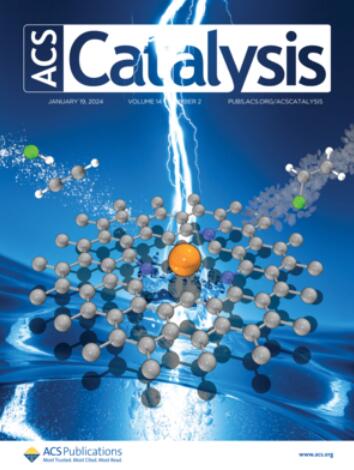通过添加CrOx提高Cu/Al2O3在甲醇蒸汽重整中的反应活性:揭示反应途径及改进机理
IF 11.3
1区 化学
Q1 CHEMISTRY, PHYSICAL
引用次数: 0
摘要
铜基催化剂广泛应用于甲醇蒸汽重整反应。然而,提高它们的性能和更深入地了解反应机制仍然是重大的挑战。本文合成了一系列Cu-y%CrOx/Al2O3催化剂。优化后的Cu-7% crox /Al2O3催化剂CH3OH转化率为93.2%,CO选择性为0.16%,260℃下产氢率为1142.7 mmol gcat-1 h-1,质量空速为14.6 h-1,明显优于Cu/Al2O3催化剂。结合原位光谱和表面反应实验表明,两种催化剂上的MSR反应主要遵循HCOO*途径。这包括CH3OH脱氢生成ch30 *,然后氧化生成HCOO*,然后分解生成H2和CO2,其中ch30 *转化为HCOO*是决定速率的步骤(RDS)。蒸汽对ch30 *和HCOO*的转化起促进作用。由ch30 *脱氢产生的少量甲醛(HCHO)倾向于解离,形成副产物CO而不是转化为HCOO*。由于CrOx的促进作用,Cu的分散性得到改善,Cu+/Cu0的比值在1.0左右,活性氧的增加有利于ch30 *与HCOO*的RDS和CO的氧化,从而使Cu-7%CrOx/Al2O3的产氢率和CO2选择性比Cu/Al2O3提高。本文章由计算机程序翻译,如有差异,请以英文原文为准。

Enhancing the Reactivity of Cu/Al2O3 for Methanol Steam Reforming through adding CrOx: Unraveling Reaction Pathways and the Mechanism for Improvement
Copper-based catalysts are widely utilized for methanol steam reforming (MSR) reactions. However, improving their performance and achieving a deeper understanding of the reaction mechanism remain significant challenges. Herein, a series of Cu-y%CrOx/Al2O3 catalysts were synthesized. The optimal Cu-7%CrOx/Al2O3 catalyst achieved a high CH3OH conversion of 93.2%, a low CO selectivity of 0.16%, and a competitive hydrogen production rate of 1142.7 mmol gcat–1 h–1 at 260 °C with a weight space velocity of 14.6 h–1, significantly outperforming the Cu/Al2O3 catalyst. Combined in situ spectroscopy and surface reaction experiments revealed that the MSR reaction on both catalysts predominantly followed the HCOO* pathway. This involves the dehydrogenation of CH3OH to CH3O*, followed by oxidation to HCOO*, and then decomposition to produce H2 and CO2, with the conversion of CH3O* to HCOO* being the rate-determining step (RDS). The steam acted as a promoter for the conversions of CH3O* and HCOO*. A small amount of formaldehyde (HCHO) derived from CH3O* dehydrogenation tends to dissociate, forming the byproduct CO rather than converting to HCOO*. Due to the promoting effect of CrOx, improved Cu dispersion, the Cu+/Cu0 ratio of around 1.0, and increased active oxygen species facilitate the RDS of CH3O* to HCOO* and the oxidation of CO, leading to an enhanced hydrogen production rate and CO2 selectivity on Cu-7%CrOx/Al2O3 compared to Cu/Al2O3.
求助全文
通过发布文献求助,成功后即可免费获取论文全文。
去求助
来源期刊

ACS Catalysis
CHEMISTRY, PHYSICAL-
CiteScore
20.80
自引率
6.20%
发文量
1253
审稿时长
1.5 months
期刊介绍:
ACS Catalysis is an esteemed journal that publishes original research in the fields of heterogeneous catalysis, molecular catalysis, and biocatalysis. It offers broad coverage across diverse areas such as life sciences, organometallics and synthesis, photochemistry and electrochemistry, drug discovery and synthesis, materials science, environmental protection, polymer discovery and synthesis, and energy and fuels.
The scope of the journal is to showcase innovative work in various aspects of catalysis. This includes new reactions and novel synthetic approaches utilizing known catalysts, the discovery or modification of new catalysts, elucidation of catalytic mechanisms through cutting-edge investigations, practical enhancements of existing processes, as well as conceptual advances in the field. Contributions to ACS Catalysis can encompass both experimental and theoretical research focused on catalytic molecules, macromolecules, and materials that exhibit catalytic turnover.
 求助内容:
求助内容: 应助结果提醒方式:
应助结果提醒方式:


